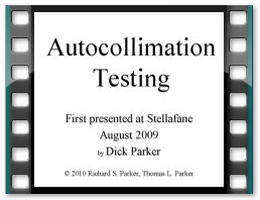|
||||
Autocollimation TestingAutocollimation Testing is a powerful, accurate and easy to use null test for a parabola. In this use, "autocollimation" means "self collimation", with the optic under test being used to first collimate (make parallel) the test illumination, and then to focus the collimated light back to a knife edge or Ronchi grating. Because it is a null test for a parabola, and no processing of intermediate data is required, you can tell at a glace through the tester if you are done, or what areas need further work. Because of this characteristic, we use autocollimation testing in the Stellafane Mirror Class, because it is quick, accurate and easy to interpret. So why don't we talk more about this test in our ATM web pages? Because you need an auxiliary optic to do this test, an accurate optical flat larger than the mirror under test. These are expensive to buy, and hard to make for first time mirror makers (but flats certainly can be made by amateurs, it's just not a project for those inexperienced at making optical surfaces). We present this video here for those who are curious about this test, or for those who may have access to a quality optical flat. This video will explain all about the autocollimation test: how it works, how it is used, an how accurate it is (and it is very accurate, because the light is reflect from the mirror under test twice, it doubles the errors, and is therefore twice as accurate as the standard single-pass knife edge or Ronchi tests). Dick Parker is an accomplished mirror maker who is a member of The Springfield Telescope Makers, a Stellafane Mirror Class Instructor, and a member of the Astronomical Society of Greater Hartford. He runs the ASGH Mirror Making Workshop in central Connecticut. The information in this video was first presented as a Tech Talk at the 2009 Stellafane Convention. |
||||
|
Back to the ATM Index Page |
||||


